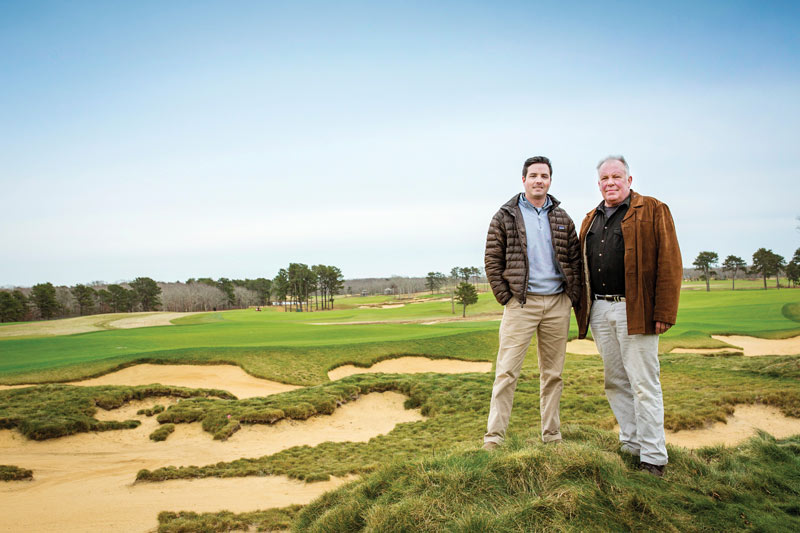
A unique succession plan brought superintendent Kevin Banks (left) and property manager Jeff Carlson, CGCS, together at the Vineyard Golf Club in Edgartown, Mass. Photo by Randi Baird
When Kevin Banks was a turfgrass management student at the University of Massachusetts Amherst, it wasn’t uncommon for decorated or otherwise experienced golf course superintendents to drop in for guest lectures. When Jeff Carlson, CGCS, came by in 2005, Banks says he remembers thinking, “Wow, this guy is crazy!”
Frankly, that’s how most students in the midst of a traditional turf management education might have appraised Carlson’s work at the Vineyard Golf Club. When permits were being sought for building this golf course on environmentally sensitive Martha’s Vineyard in Edgartown, Mass., in 1998, developers were obliged to promise the local conservation commission that the prospective golf course would be managed in an entirely organic manner.
The Vineyard Golf Club opened for play in 2002, and Banks graduated in 2008. He would then apprentice at several traditional clubs before this story came full circle — Banks took over for Carlson as head golf course superintendent at the Vineyard Golf Club on April 1, 2015.
“I guess I’m the crazy one now,” the nine-year GCSAA member says.
Two-plus years into his tenure, Banks has more than warmed to the nonconforming aspects of his job, one of the few in golf course management that takes the organic approach from mere trend or direction to guiding principle.
“It’s definitely been a challenge, but I’ve also definitely become addicted to it,” Banks admits.
An industry trend unfolds
Just 31, Banks today finds himself at the crux of another nascent industry trend, a phenomenon where head superintendents hire and groom their replacements, having accepted another position at the same club. Carlson stepped aside in the spring of 2015, but he remains at the Vineyard Golf Club as property manager, where he oversees capital projects — a just-concluded Gil Hanse redesign, for example.
The idea of having the previous superintendent at the club — perhaps hovering, perhaps exerting undue or unwanted influence — may strike some as awkward. Not Banks, and here, the organic dictates governing turf management at the club intertwine with these issues of succession.
“Before I took this job, I knew who Jeff Carlson was. Almost everybody in New England and New York did too, and I’m sure that reputation extends even farther than that,” Banks says. “He has been the organic ambassador for my entire turfgrass career. Having him help manage the golf course with me my first season here was a really sensible transition. I knew it would be very different for me, at first, but Jeff knew exactly where to expect an outbreak. He knew where we would first see weed pressure, and all this input came with his very relaxed and calm presence.
“I will always thank him for being patient and mentoring me into a truly organic manager — something I take great pride in today,” Banks adds.
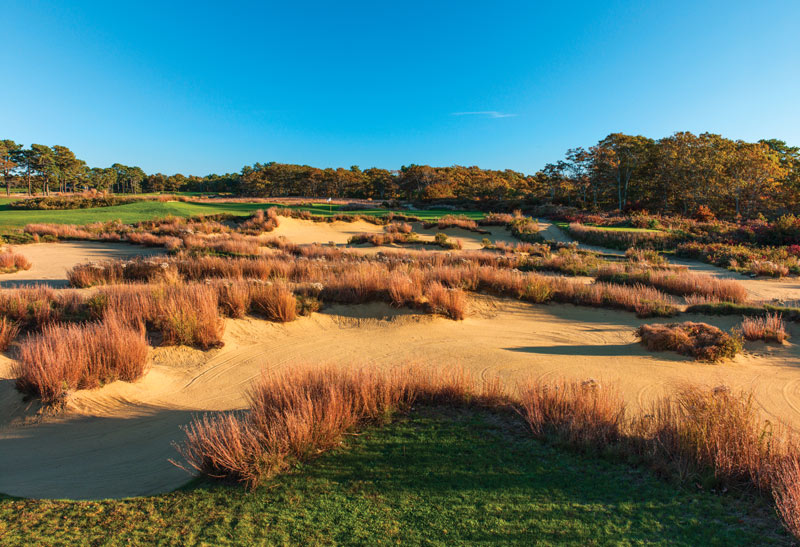
The first new golf course to be built on Martha’s Vineyard in 30 years when it opened in 2002, the Vineyard Golf Club was designed, built and is maintained in an all-organic manner to satisfy the community’s strict environmental standards. Photo by Larry Lambrecht
Can Banks imagine having taken on the organic learning curve without Carlson there, on-site?
“Not really,” he answers. “Jeff was very patient. My first year, the disease we encountered in certain areas maybe should not have happened. I believed moisture levels were adequate and acceptable enough to fight disease pressure. They weren’t. But Jeff sat back and let me learn from my mistakes, and watched me grow.
“From the beginning, I was talking to anyone and everyone to get my head around the issues. And I still do that.”
Banks says he frequently talks with colleagues, companies and researchers about the specific issues he faces. Frank Rossi, Ph.D., of Cornell University and recipient of GCSAA’s 2018 President’s Award for Environmental Stewardship, is “a great resource,” he adds.
“But the way I look at it, Jeff is my best researcher. As often as I do interact with all these organic contacts and their ideas, I still take most of them with a grain of salt. They can recommend what they think is right, but you must compare that to what I’m finding here on the ground and what I think is right — and to what Jeff thinks, because he’s done it.”
A less firm mentality
Banks did not experience any sort of instant, organic epiphany that day Carlson visited UMass. In fact, before and after graduation, Banks would spend 11 seasons learning and practicing the traditional art and science of turfgrass management, first at Huntington Crescent Club on Long Island (as assistant-in-training/spray technician), then as assistant superintendent at Framingham (Mass.) Country Club, and finally as senior assistant at Nantucket Golf Club.
“Being the lead assistant and working under Mark Lucas at Nantucket Golf Club was always a dream job,” Banks says. “I still remember the day when I told my wife the position had opened and it was mine to have: a very private club with a great budget and lots of capital projects and improvements. I learned a ton there, but part of the practices revolved around the use of pesticides, the rates, resistance, FRAC (Fungicide Resistance Action Committee) codes, etc.”
Nantucket and Martha’s Vineyard are twin islands that sit just offshore from Cape Cod, and both — on account of their isolated, sensitive ecosystems — are known for their strict local environmental statutes. Lucas and his top assistant managed Nantucket GC on a very responsible — but still traditional — basis. So, when Banks made the move to the Vineyard Golf Club in April 2015, a great deal of that training was more or less moot.
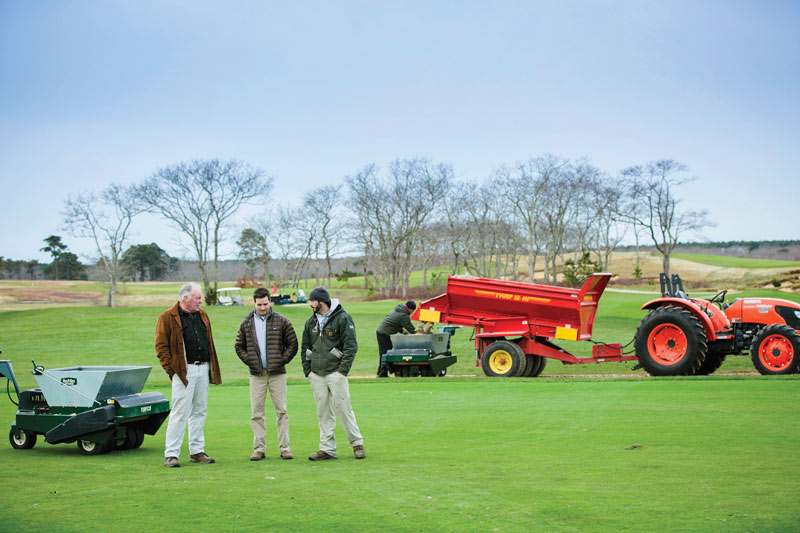
At the Vineyard Golf Club, the general strategy when dealing with pests and disease — one first developed by Carlson and now practiced by Banks — is to constantly feed the plant “in an attempt to grow the plant out of disease situations,” Banks says. Photo by Randi Baird
“In our climate, which is coastal, it stays wet with a lot of dew, but we have to think outside the box when it comes to managing that moisture,” Banks explains. “With no chemical inputs, the big issue here is Northeastern dollar spot, and that first year we got a lot of it — that was me just not having the experience Jeff has or being ready to rely on that perfect balance of nitrogen and irrigation as a fungicide. That’s what we do here, in a weird way: We are constantly feeding the plant in an attempt to grow the plant out of disease situations.”
Here was another radical departure from the regimen at Nantucket GC, where crews would spray greens weekly, as many courses do, and stress out the turf to a level necessary to achieve firm and fast conditions.
“Many courses will use 1 pound of N per thousand on green surfaces. That’s the ‘lean-and-mean, firm-and-fast’ mentality. Here, we feed the plant more frequently, but at lower levels of N. We want the plant constantly growing,” Banks notes. “A lot of courses will minimize N on the greens to get them firm and fast — and we’re going in the opposite direction. We are limited as to how much N we can use, to be honest, but the key is to schedule applications accordingly and apply when the plant needs it most.
“As a result, we’re just not as firm and fast as many clubs,” Banks continues. “Once the course matures, I see us achieving that goal. But our membership understands the program here, and that’s so important, that communication. Maybe we’re not as firm and fast, but we topdress like anyone else, if not more. We’re growing the greens out of disease, adding sand multiple times per week, and relying on other cultural practices to achieve the firmness.”
Adventures in organics at the Vineyard Golf Club
Two-plus years into his tenure, Banks has become a hyper-informed, often adventurous consumer of products, because organic turf care remains such a new discipline — something that similarly describes the product market taking shape around it. (Read more from Banks on his organic strategy in Organic golf course management: Lessons from Vineyard Golf Club.)
He’s a fan of the organic fungicide Civitas (Intelligro), “which is like an IPM pesticide, the organic base of all my sprays,” he says. The Vineyard Golf Club’s spray program is a very different exercise. “There aren’t many biological fungicides out there. What we do use is a mix of four biofungicides. I wouldn’t say our mix is curative, but it does help strengthen the plant and maintain healthy roots when stress is really high. As long as we maintain healthy moisture, a healthy growing plant, biofungicides have been successful, even in the high-stress periods. In 2017, it was.”
Banks also had good things to say about EcoGuard from LebanonTurf, where the active ingredient is a soil-borne bacterium that has exhibited the ability to fight off fungi such as dollar spot and brown patch. “This was only my second year with it, but it’s definitely one of my go-tos,” Banks says.
He’s also high on Rhapsody from Bayer, a biological fungicide, and micronutrients with biostimulants such as foliar liquid seaweed: “I don’t know if it cures anything, but I do think it maintains a healthy growing plant.”
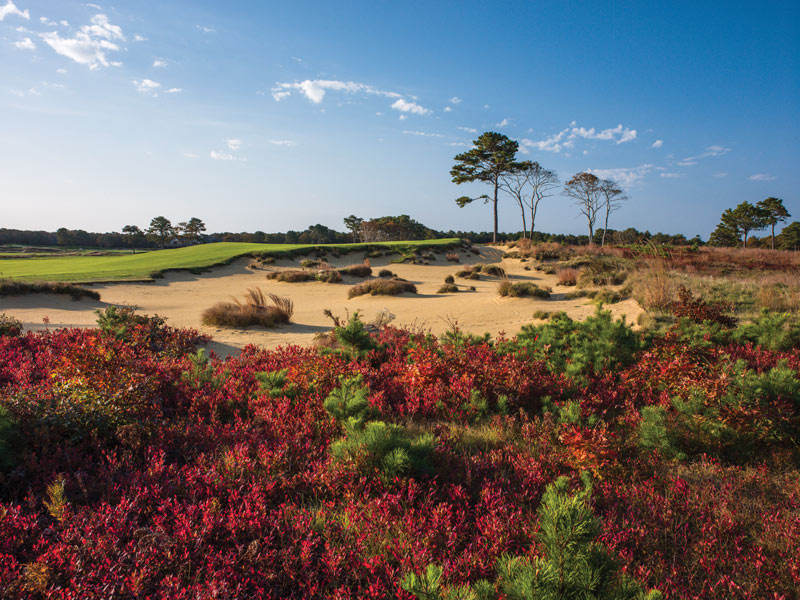
The Vineyard Golf Club underwent a redesign at the hands of Gil Hanse and Jim Wagner. The front nine was completed in 2013, while the back nine was finished in 2015. Shown here is the club’s ninth hole. Photo by Larry Lambrecht
While Banks maintains a network of organic turf “consiglieri,” headed by Carlson and Rossi, fellow superintendents interested in organics are increasingly seeking him out for advice. Their questions are “all over the board,” he says, but few of these colleagues have a real desire to follow Banks into the all-organic category.
“They want to be more environmentally sensitive, which is totally doable, but I would never recommend everything I do. Just certain directions,” Banks says. “Our membership is unique. They understand what the regulations are here. If a colleague tried some of this stuff, say, in the Boston area, his job may be in jeopardy quicker than mine. Those expectations are so important. But there are certain times of the year, less stressful times, when I would preach against certain things — like when you see two or three grubs and initially think to treat the entire property. However, this is much easier for me to say now, being on this side of organic turf management.”
The predecessor’s tale
Carlson’s organic credentials predate his tenure at the Vineyard Golf Club. Mainly, they stem from his experience as head superintendent at Widow’s Walk Golf Course, a Michael Hurdzan design that opened in 1996 on a former sand quarry in the coastal Massachusetts town of Scituate. Hurdzan and Carlson worked together through construction and grow-in to craft a day-to-day management approach that was notably organic and short on chemical inputs, especially for that time. When Carlson left in 1997 to undertake some construction and grow-in consulting, most of the practices he’d developed were abandoned by his successors, never to be revived.
That was a disappointment, the 33-year GCSAA member says, but that’s the way of the golfing world: Superintendents leave, and their replacements invariably bring a different approach. Of course, that wouldn’t happen at the Vineyard Golf Club, where the organic mandate had been baked into the permitting process.
There was just one problem.
“At some point, the club president comes up to me, and I’m paraphrasing here, but he says, ‘You’re getting old and you could die, and we don’t have anyone who really knows how do to this job.’ And that was pretty much true,” Carlson says. “The club hired me because of my connection to Widow’s Walk, but today you can count on one hand the guys who deal with the sort of restrictions we have at the Vineyard Club — and you’d probably have some fingers left over. From a business standpoint, they couldn’t just run an ad for this job.”
Carlson’s solution was to form a small hiring committee whose members (Jim Skorulski from the USGA Green Section, Rossi, the Vineyard Golf Club’s general manager, Scott Anderson, golf course architect Gil Hanse and Carlson himself) would reach out to their various networks to compile a list of candidates. One round of phone interviews cut the list to 12; another pared it to three. Those candidates were presented to the board with the understanding that any new hire would have Carlson as an on-site resource.
Banks’ tenure at Nantucket GC turned out to be pretty important in his getting the offer, despite the traditional turf care techniques deployed there.
“Island living is not for everyone,” Carlson explains. “We’ve had lots of candidates for different positions here — general manager, chefs, assistant supers — and they seem real interested until they bring their families out. Their wives are like, ‘You’re kidding, right?’ It can be very isolating out here, especially in the winter.
“We could tell when we met Kevin’s wife, Sarah, that they had already adapted to island life,” he continues. “In fact, moving to Martha’s Vineyard from Nantucket is a bit like going to Manhattan.”
Though tiny (just 87 square miles) in the grand scheme of things, Martha’s Vineyard is indeed a lot bigger than Nantucket. It’s also closer to the mainland, so the ferry rides are shorter and more frequent. The Vineyard boasts several towns (not just one) along with more shops, restaurants and year-round residents. It’s also more affordable than Nantucket.
Still, the on-course transition remained delicate and daunting. Who takes a new job and is obliged to deal so frequently with — and dependently on — the guy he replaced, who just happens to be sitting in an office down the hall?
“It was a very unique situation with Jeff still here, but maybe not in the way you think,” Banks says. “The biggest obstacle was to get his trust — to allow me to do my thing while managing a healthy working relationship between us, one where I could go to him and talk about literally anything. Jeff was great, and he truly did mentor me, but it’s one thing to discuss something. It’s another to experience it.”
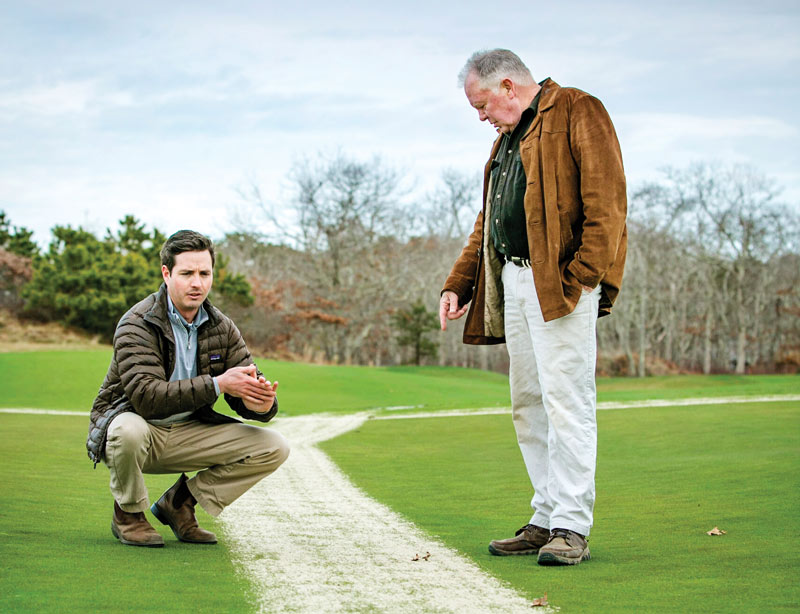
Banks (left) has leaned on Carlson’s array of experience managing organic golf courses since Banks took over as superintendent at the Vineyard Golf Club in 2015. Photo by Randi Baird
Carlson gathered his organic experience over the course of 20 years. That Banks has brought himself up to speed in just two speaks more to the quality of the hire.
“From my perspective,” Carlson says, “probably the hardest thing for anyone coming here would have been the water management, especially at the beginning. To understand that backward relationship we have here between dollar spot and water? That’s so hard. Good superintendents like Kevin want to shut it off, hand-water and get things hard and fast. That’s a little tricky, because hard, fast and dry invites disease problems that will surprise you. That’s one thing. The other is being patient — with the crabgrass situation and other weeds — and Kevin has been really great with that.
“Managing without the benefit of pesticides changes your whole perspective. The philosophy here has been, ‘Don’t have a heart attack.’ First, try to figure out what cultural and situational things play into it. You’ve got to understand the situation. A little bit of disease out on a fairway in some remote corner of the golf course is not the end of the world. Dollar spot is a tissue disease, so if you can get rid of it by growing your way out of it, you’re eliminating the need for inputs.
“We’re a product business. But the reaction to disease and trouble has always been, ‘What product will take me out of this?’ We work to get away from that philosophy here.”
Carlson also believes communication is critical to everything the superintendent must do at the Vineyard Golf Club, and he says this may be Banks’ greatest strength, from educating interns “and getting them to do things that actually help us,” to his continual communication with the board chairman, the GM and the pro — for these are the people who join Banks and Carlson in communicating the unique management realities at the Vineyard Golf Club to the members themselves.
“What we do here is pretty unique, but the enthusiastic and unequivocal acceptance from members has been astounding to me,” Carlson says. “I don’t know why it keeps surprising me.”
Maybe because most all of them belong to at least one other first-class golf club where the only mention of “organic” is on the dinner menu?
“That’s probably it,” Carlson admits. “We’d like for them to bring guests here and have those guests never know we’re completely organic. We’re getting there.”
Hal Phillips is the managing director of Mandarin Media and a frequent contributor to GCM.